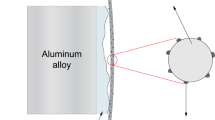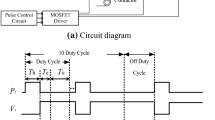Abstract
Aiming at the problem of low efficiency in cutting silicon crystals with traditional wire electrical discharge machining (wire EDM) equipment, this paper proposes a method to improve the efficiency of electrical discharge cutting for silicon crystals by using composite pulse power to process semiconductors. This paper established a wire EDM equivalent circuit model, analyzed the magnitude of the discharge sustaining voltage on metal and semiconductor in wire EDM, studied the current-voltage characteristics of silicon crystals under a composite power supply, and compared the machining performance with and without the new power supply. The experiments show that, compared with the single power supply, the composite power supply can increase the machining current, and the existence of its high-voltage module can increase the probability of forming the discharge channel, which is convenient for wire EDM; using this power supply, the traditional servo system based on voltage detection can be used to distinguish the three typical machining states (short circuit, normal discharge, and no-load) in wire EDM for semiconductor machining, realize an effective servo feed, and improve machining stability; compared with the single power supply with an open voltage of 80 V, the new power supply with an open voltage of 80 V for the low-voltage module and 120 V for the high-voltage module has a certain increase in surface roughness, the processing efficiency is increased by 75%, and the kerf width is increased by 3.4%.















Similar content being viewed by others
References
Pei ZJ, Kassir S, Bhagavat M, Fisher GR (2004) An experimental investigation into soft-pad grinding of wire-sawn silicon wafers. Int J Mach Tools Manuf 44(2–3):299–306
Kohn VG, Prosekov PA, Seregin AY, Kulikov AG, Pisarevsky YV, Blagov AE, Kovalchuk MV (2019) Experimental study of two-beam X-ray diffractometry using synchrotron radiation. Crystallogr Rep 64(1):24–29
Tajiri H, Yamazaki H, Ohashi H, Goto S, Sakata O, Ishikawa T (2019) A middle energy-bandwidth X-ray monochromator for high-flux synchrotron diffraction: revisiting asymmetrically cut silicon crystals. J Synchrotron Radiat 26(3):750–755
Sreejith PS, Udupa G, Noor YBM, Ngoi BKA (2001) Recent advances in machining of silicon wafers for semiconductor applications. Int J Adv Manuf Technol 17(3):157–162
Zhou WW, Liu ZD, Zhang B, Qiu MB, Chen HR, Shen LD (2018) Experimental research on semiconductor shaping by abrasive-spark hybrid machining. Int J Adv Manuf Technol 94:2209–2216
Hardin CW, Qu J, Shih AJ (2004) Fixed abrasive diamond wire saw slicing of single-crystal silicon carbide wafers. Mater Manuf Process 19(2):355–367
Liu ZD, Wang W, Qiu MB, Tian ZJ, Huang YH (2008) Experimental research of WEDM-HS on monocrystal silicon cutting. J Nanjing Univ Aeronaut Astronaut 6:007
Tian Y, Qiu MB, Liu ZD, Tian ZJ, Huang YH (2014) Discharge cutting technology for specific crystallographic planes of monocrystalline silicon. Mater Sci Semicond Process 27(1):546–552
Muthuramalingam T, Mohan B (2015) A review on influence of electrical process parameters in EDM process. Arch Civ Mech Eng 15(1):87–94
Li SJ, Yin XC, Jia Z, Li ZP, Han LL (2020) Modeling of plasma temperature distribution during micro-EDM for silicon single crystal. Int J Adv Manuf Technol 107:1731–1739
Daud ND, AbuZaiter A, Leow PL, Mohamed Ali MS (2018) The effects of the silicon wafer resistivity on the performance of microelectrical discharge machining. Int J Adv Manuf Technol 95:257–266
Luo YF, Chen CG, Tong ZF (1992) Investigation of silicon wafering by wire EDM. J Mater Sci 27(21):5805–5810
Kunieda M, Ojima S (2000) Improvement of EDM efficiency of silicon single crystal through ohmic contact. Precis Eng 24(8):185–190
Saleh T, Rasheed AN, Muthalif AGA (2015) Experimental study on improving μ-WEDM and μ-EDM of doped silicon by temporary metallic coating. Int J Adv Manuf Technol 78:1651–1663
Qiu MB, Liu ZD, Tian ZJ, Wang W, Huang YH (2013) Study of unidirectional conductivity on the electrical discharge machining of semiconductor crystals. Precis Eng 37:902–907
Yu PH, Lee HK, Lin YX, Qin SJ, Yan BH, Huang FY (2011) Machining characteristics of polycrystalline silicon by wire electrical discharge machining. Mater Manuf Process 26(12):1443–1450
Yang F, Yang J, Yao K, Hua H (2019) Adaptive voltage position control for pulse power supply in electrical discharge machining. IEEE Trans Ind Electron 66(8):5895–5906
Yu PH, Lin YX, Lee HK, Mai CC, Yan BH (2011) Improvement of wire electrical discharge machining efficiency in machining polycrystalline silicon with auxiliary-pulse voltage supply. Int J Adv Manuf Technol 57(9–12):991–1001
Liu LC, Qiu MB, Shao CJ, Zhang M, Zhao JF (2019) Research on wire-cut electrical discharge machining constant discharge probability pulse power source for silicon crystals. Int J Adv Manuf Technol 100(5–8):1815–1824
Liu ZD, Chen HR, Pan HJ, Qiu MB, Tian ZJ (2015) Automatic control of WEDM servo for silicon processing using current pulse probability detection. Int J Adv Manuf Technol 76:367–374
Yang F, Bellotti M, Hua H, Yang J, Qian J, Reynaerts D (2018) Experimental analysis of normal spark discharge voltage and current with a RC-type generator in micro-EDM. Int J Adv Manuf Technol 96(5–8):2963–2972
Jabbaripour B, Sadeghi MH, Faridvand S, Shabgard MR (2012) Investigating the effects of EDM parameters on surface integrity, MRR and TWR in machining of Ti-6Al-4V. Mach Sci Technol 16(3):419–444
Pan HJ, Liu ZD, Qiu MB, Tian ZJ (2014) Study on climbing type current phenomenon in EDM of semiconductors. China Mech Eng 25(13):1773–1778
Pan HJ, Liu ZD, Qin MB, Huang SJ, Tian ZJ (2013) Study on the high efficiency mechanism in WEDM of semiconductor in micro contact condition. J Synth Cryst 42(7):1336–1342
Acknowledgments
We thank all the individuals who contributed to this manuscript.
Funding
This work is supported by the National Natural Science Foundation of China (Grant No. 51675272).
Author information
Authors and Affiliations
Corresponding author
Additional information
Publisher’s note
Springer Nature remains neutral with regard to jurisdictional claims in published maps and institutional affiliations.
Rights and permissions
About this article
Cite this article
Zhao, J., Qiu, M., Yan, J. et al. Research on the machining characteristics of composite pulse power supply for the electrical discharge machining of semiconductor silicon crystal. Int J Adv Manuf Technol 111, 2377–2389 (2020). https://doi.org/10.1007/s00170-020-06306-6
Received:
Accepted:
Published:
Issue Date:
DOI: https://doi.org/10.1007/s00170-020-06306-6




